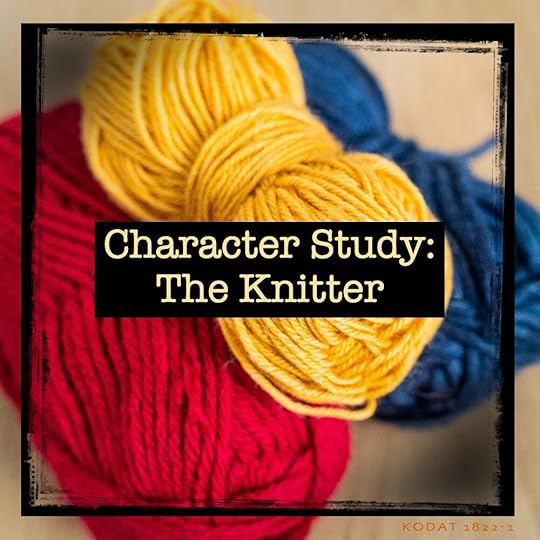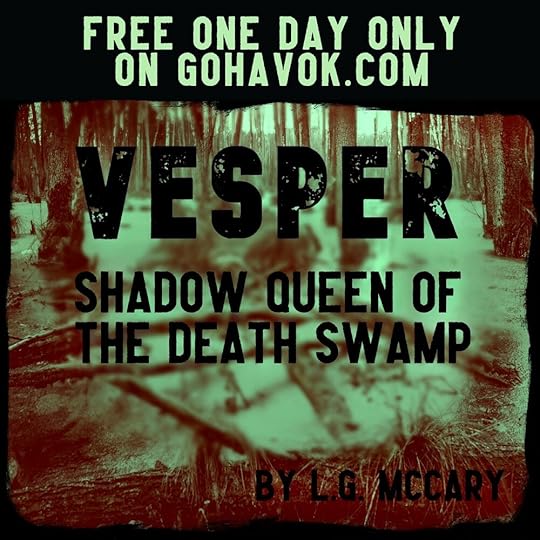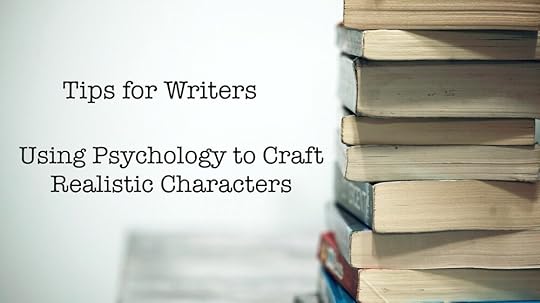L.G. McCary's Blog, page 2
February 17, 2021
New Article at Lorehaven on Reading Fiction for Personal Growth
Before you read, know that I think Billy Coffey is awesome and that he doesn’t have bad ideas. He was just out of my reading comfort zone when I discovered him. Now I count him as one of my biggest influences as an author! As far as the other three authors, you’ll need to read the article to see why I disagree with them.
New at Lorehaven!
Stories with Bad Ideas Can Still Help Us GrowYou may often hear people say they’re reading nonfiction books to learn something or grow in a particular area. But why do you rarely hear the same language about novels?
See full article at Lorehaven.com
December 26, 2020
Meet Ben, the Concierge of the Sixteen Sunrises Hotel
It’s time for my annual spooky snowman story! This year is more wacky, dark humor than spooky.
Ben is the concierge for the very first space hotel, The Sixteen Sunrises. He’s paid to manage guests’ needs in the world’s first space hotel. He’s paid to know the dinner menus, curate unique space experiences, and ensure the safety of all guests in zero-G.
He is not paid to care.
I loved writing Ben, and I hope you enjoy his snarky tour/safety speech. Merry Christmas, and here’s to a much brighter, safer, healthier New Year in 2021 for all of us!

August 11, 2020
Check out "A Recipe for Disaster!" at Havok!
You'd butter 🧈 read my story at Havok! I stewed 🍲 over it for weeks! If your spouse got the half-baked 🍞 idea to gut your kitchen and replace it with a fully-automatic, voice-activated, robotic food maker, would it make you salty 🧂 or would you relish 🥒 the idea of not having to cook? Maybe you wouldn’t carrot 🥕 all either way?
Check out “A Recipe for Disaster!” I hope you’re as egg-cited🥚 as I am!

August 6, 2020
Character Study: The Knitter

Photo by Les Triconautes on Unsplash
When my husband was in seminary, I commuted to Dallas until I found a job closer to home in Fort Worth. It was a two-hour train ride every morning to the university, getting on at the first stop and off at the very last. Then I did it all in reverse every evening to return to our absurdly tiny seminary apartment. Four hours a day, every weekday. It was a long nine months on the good 'ol TRE.
As you might imagine, I met a lot of interesting characters on that infamous train. Still, I'll never forget the evening I met a woman I'll call "The Knitter" or "K" for short. I first saw the Knitter at the train's second stop. I had decided to move seats between stops, and it was impossible not to notice her. A pair of brightly colored spectacles made her eyes larger than life beneath a shock of wild salt-and-pepper hair. She wore a handmade burgundy shawl and black clogs. Her knitting needles flew faster than my eyes could follow, but she had a friendly look that made you want to talk to her or at least watch the magic being woven betwixt her knitting needles.
I crochet, but I did not know how to knit at the time. I caught her attention and asked if I could watch as she worked on a pair of socks. She slowed her lightning-quick stitches so I could watch the pattern take shape and told me about her favorite sock yarns, knitting patterns, and the knitting podcast she'd found.
"The host is British," she said with a wink, "so after a long day, I grab a skein or two, turn on the podcast, and let that soothing British accent relax me."
She had a musical sound to her voice and a loud laugh that made you join in. We became train friends, and I looked for her every evening. She was a knitting machine, finishing a sock in a single day. Each time we met, she had a different project.
"That's an interesting sock pattern." I pointed to a fine yellow yarn.
"It's historical!" She explained a duchess or countess of minor importance wore the same socks in a centuries-old portrait. Another night she brought her famous angel shawl, a five-foot-wide navy wrap in fingering weight yarn that looked like a pair of wings. (I still want to make one for myself!)
"So what are you making tonight?" I asked one evening as she picked at a ball of navy wool with visible frustration.
"I don't know exactly," she said, half to me and half to the fibers between her needles. "I've tried this with several different patterns, and it hasn't turned out." She gave a long sigh. "Sometimes, you have to ask the yarn what it wants to be."
It still makes me laugh how she treated her yarn as if each skein had a different personality. But my favorite memory of K was her telling me about her conversion to Mormonism.
She converted later in life after a divorce and raising several children alone. She told me how she found it comforting to chat with her women's group on Sundays, knitting the entire time. She usually made it through a substantial portion of a sock between verses. The idea of her debating the finer points of the Book of Mormon, needles clicking all the while, struck me as funny.
"Coffee and knitting," I said. "That's a pleasant Sunday morning. Oh, wait! You can't drink coffee, can you?"
She paused her knitting momentarily, a dreamy look in her eye.
"No, I don't. And it was a terrible loss, to be honest," she said. "I didn't know much about the standards at the beginning, so I buzzed along, doing my best. And one evening, I went to Braum's to get ice cream."
(For those unfamiliar with Braum's, it's a regional ice cream and dairy store in Oklahoma, Texas, and Kansas, and it's better than Bluebell. Fight me, Lori.)
"I was just sitting there, enjoying my favorite single dip." She sighed dramatically.
"What kind?"
"Cappuccino Chunky Chocolate."
"Oh, no!" I practically snorted with laughter.
"Oh, yes," she said, her voice full of mourning. "I was halfway done before realized what I was eating. I didn't know what to do. I'd already paid for it, and it was my favorite!"
She demonstrated her horrified and depressed face as she looked at an imaginary contraband ice cream cone in her hand.
"I finally prayed, 'Well, Heavenly Father, just let me finish this. After that, I'm done, I promise.' And then I said goodbye to cappuccino forever."
Whenever I meet a Mormon now, I think of the Knitter, imaginary ice cream cone in hand, sighing over her final goodbye to caffeine. Thank you, K, for making a dreary commute so much brighter. I still hang the beautiful miniature stocking you made for me on our tree every Christmas.

July 7, 2020
“Vesper, Shadow Queen of the Death Swamp” is here!

Yes, I have a new story at Havok! Check out “Vesper, Shadow Queen of the Death Swamp!”
Vesper is delightfully crabby and sarcastic, and I can’t wait for you to visit her in her swamp kingdom “that smells like rotten eggs and disappointment.” If you like Vesper, please comment at gohavok.com and share the story on social media! And be sure to check out the ad link below the story because I have a special gift for readers you won’t want to miss!
Thank you for your support!
June 25, 2020
The Battle Cry of the General(ist)
I've been reading a fascinating book called Range: Why Generalists Triumph in a Specialized World by David Epstein. The book has its problems (much like Malcolm Gladwell's books on similar topics have their blind spots), but it has given me a lot of unexpected peace.
Because I'm all over the place, and unapologetically so.I love sci-fi and supernatural, but I read and write all kinds of weird stuff. I'm a literary omnivore, taking in historical narrative, memoir, science, theology, and philosophy in addition to my favorite dystopian, post-apocalyptic, sci-fi, and supernatural fiction. The frequent advice from writing gurus is to pick a genre and stick with it. That feels impossible to me, and Range helped me understand why.
In discussing the success or failure of new comic books, Epstein describes: "...what helped creators make better comics on average and innovate? The answer (in addition to not being overworked) was how many of twenty-two different genres a creator had worked in, from comedy and crime, to fantasy, adult, nonfiction, and sci-fi. Where length of experience did not differentiate creators, breadth of experience did. Broad genre experience made creators better on average and more likely to innovate." (emphasis mine)
So the fact that I have moved from fairytale retellings in play form (middle school) to historical adventure (high school) to parody and sketch comedy (college) to psychological/historical thriller (college) to serial killer mystery (post-college) to supernatural action (nobody knows about that one 🤫) to YA science fiction to adult supernatural (That Whiter Host) to YA alternate universe sci-fi (my new mermaid series) and allegorical fantasy (Dr. Herpeton) is a GOOD thing.
Not necessarily good from an editor's perspective, but it's a great thing for my craft.Range frequently brings up the fallacy of sunk costs, which is something I have been plagued by over the years. When I started writing in earnest, I had no clue what I was doing. I could write solid dialogue, but that was about it. It took three more false starts before I could settle. I shifted genres six times. I invested six years in my Mars series before I switched to my adult supernatural novel. That novel took me another six years to complete. That is a lot of time to invest in entirely unrelated projects. It was like pulling teeth to set them aside for something else, especially when I had little evidence I could succeed.
A few years ago, a published author at a conference encouraged me by saying, "You don't start a new project from the first floor. You've already built that. You are building on everything you have already learned and created, not starting from nothing."
Almost twenty years from my first attempt at a novel, I don't regret all the rabbit trails and switchbacks. I was getting the lay of the land. I think I will always be a little "all over the map" in my writing, but if you were to set all my projects on top of each other, you'd find the same landmarks. I write to explore hard questions, experience new worlds, and glorify Christ.
I think those goals transcend genre. Hopefully, someday a publisher will feel the same.
What about you? Are you a jack or jill of all trades? Do you think it has helped you to have a wide array of interests? Let me know your thoughts in the comments!
June 11, 2020
Theology Matters: Aesthetic Standards, Imago Dei, and Becoming Omnivorous

Photo by Lena Paulin on Unsplash
As a result of Mary Jo Sharp’s excellent book, Why I Still Believe: A Former Atheist’s Reckoning with the Bad Reputation Christians Give a Good God, I’ve been following a long rabbit trail into the field of aesthetics. This trail has led me to several good books on the subject, and I’m currently in the middle of Good Taste, Bad Taste, and Christian Taste: Aesthetics in Religious Life by Frank Burch Brown. I’d like to share two quotes that stuck out to me so far.
“...contrary to what has commonly been believed in the past, the grounds for evaluating art--including Christian art--can be quite varied, and appropriately so. There is no one set of criteria suitable for all works and in every circumstance. Recognizing that allows us to steer a middle course between indiscriminate acceptance of every aesthetic choice and rigid application of a particular set of aesthetic rules presumed to be universal. Standards can shift, depending on context, without this meaning that one must abandon standards altogether.”
And later:
“It must be said that people of the church are ill-served by the common notion that knowing what they already like should preclude questions as to its relative value. Perceiving, enjoying, and judging--all three aspects of taste have as much to do with stretching and with learning as they do with inherent disposition... Taste is not just in the genes; it is also in communal conditioning, in learning, in expanding what one likes and also judges worthy of others’ attention.”
This is where my experience as a pastor’s wife rears its head: my first thought in response to these quotes was “worship wars.” I think it likely that every Christian has observed or even participated in an escalating argument about church music, decor, or renovation. These quotes are relevant to the underlying issues that cause those arguments and how they can be resolved (or at least debated with less heat).
First, consider, “standards can shift depending on context, without this meaning that one must abandon standards altogether.” Brown is primarily talking about music, but this sentence applies to art, architecture, and what other denominations call liturgy (Baptists like me have a liturgy, too. Ask any worship pastor who has tried to change when the ushers pass the plates). Having been a part of nine different congregations, seven of which were Southern Baptist, I can say that context matters to aesthetic standards. What is considered beautiful and worshipful in Maryland would not fly in Texas, and vice versa. I’m not obligated to accept every worship style wholesale, but it would be equally silly to demand my Marylander siblings adopt Texas norms. That would be the McDonaldization of church! There is a place for cathedrals and “Baptist barns,” for praise dance and solemn assembly, for colorful worship banners and stark white walls, for stained glass under stone arches and exposed ventilation ducts with acoustic panels.
And that’s where the second quote comes in: our tastes can be expanded. “Taste is not just in the genes; it is also in communal conditioning...”
We tend to behave as if our tastes are permanently fixed and that if we don’t like something now, we will never like it. But that’s ridiculous! We are not static as human beings, so our taste cannot be static. I’d even argue that static quickly becomes stagnant. Just look at the worship of a dying church.
I loved hymns growing up. I love praise choruses now. I grew up liking baroque and Impressionist paintings, but I also like Jackson Pollock, Yayoi Kusama, and Makoto Fujimura! I have experienced the transcendence of God’s beauty in the high stone vaults and intricate mosaics of Sacre Coeur in Paris and the worn carpet and simple plaster walls of a tiny Kansas church. The ultimate standard of beauty found in God is not so narrow as to lead to forced uniformity. The human ability to create beauty is part of Imago Dei, and just as Christians have different roles within the body, we also have different aesthetic gifts and tastes. The diversity of our creative work is a reflection of our infinitely creative Father.
We should be an omnivorous people, appreciating beauty wherever we find it. The word “omnivorous” is often associated with consuming without discernment, but we aren’t raccoons digging through the trash. We are children at the banquet of our Father with delights of every shape, color, and size for our communal enjoyment. If a brother or sister shares something they love and find beautiful, can you refuse it or even demand they only consume things you already prefer? That’s toddler-like selfishness.
I’m going to plant a flag on this one: to claim that aesthetics do not matter or to refuse to learn about new forms of art and grow in appreciation and understanding is to deny the outworking of common grace and Imago Dei in the world.
Be aesthetic omnivores, brothers and sisters. There is beauty everywhere, and it all points to the ultimate source of beauty: Christ.

Luke- Prodigal God by Makoto Fujimura as seen at the Museum of the Bible in Washington, DC
“We, today, have a language to celebrate waywardness, but we do not have a cultural language to bring people back home.” -Makoto Fujimura
April 22, 2020
Writing Technique: Using Psychology to Craft Realistic Characters
I have a bachelor's in psychology, which means I know enough to mess with your head but not enough to diagnose your problems. It also means I know a lot of random information about the human psyche, and over the years, I inadvertently created my own theory of personality.
Since I use my theory to create "round" realistic characters, I thought it might help other writers. If you look around the internet, there are thousands of worksheets for character creation. They ask for likes, dislikes, family trees, favorite foods, and spirit animals. But you know what? I don't know the eye color of the villain in That Whiter Host. It's not relevant. I don't remember what hair color one of the main characters has half the time, and no one has noticed.
Do you know why?
Because not all information you can know about a character is relevant to a story. It does a writer no good to figure out the minutiae of a character's life when it doesn't make any difference to the book. My personality theory focuses on the pieces of a character critical to the story and doesn't waste time on their favorite breakfast cereal. Curious?
(One warning: if you happen to be a counselor or mental health professional, know that I've muddled and mixed multiple theories with reckless abandon. I claim no credentials other than my bachelor's degree! All these theories are for writing purposes, not research or therapy. With that disclaimer out of the way, let's begin!)
First of all, you need to know what cognitive dissonance means.I see you yawning already! Stop it! I want you to know the technical definition before I explain how I use the concept.
Cognitive dissonance, a concept created by Leon Festinger in the 1950s, occurs when an individual has conflicting attitudes, beliefs, or behaviors. Specifically, it can be two conflicting beliefs or attitudes ("I love cats, but I hate cat hair all over my house") or behavior that contradicts a belief ("I hate gambling, but I work for a casino").
Cognitive dissonance theory says we are all seeking a harmonious inner self and will find a way to make ourselves internally consistent when confronted with cognitive dissonance. Everyone's response to dissonance is different. The specific circumstances creating the dissonance may elicit different reactions from the same person.
There are three ways to reduce cognitive dissonance (according to most researchers):
Reduce the dissonant belief's importance
"That one voice teacher says I can't sing, but he just doesn't like my style."
Add more beliefs that outweigh the dissonant belief
"My mom and dad have always said I'm a great singer! And my boyfriend loves my voice! My friends love me at karaoke!"
Change the dissonant belief
"Everyone was laughing at my audition at American Idol. Now that I can hear my voice on TV, I'm so embarrassed. I can't sing! What was I thinking???"
Once I learned this concept, I saw it everywhere. It explained so many things I saw in friends and society, and I ran with it. Cognitive dissonance combined with the rest of my education, and suddenly I had a theory of personality uniquely suited for writing fiction. It’s not like I tried to do that (because yes, I started out analyzing my friends using these ideas and still do), but now, looking back, I see how this theory is perfect for character creation. After all, what is the central focus of any good story?
Conflict.
Because cognitive dissonance resolution explains how a character will react to conflict, it allows an author to zero in on the crucial part of the character's personality for storytelling.
Confused? How about I give you three versions of a story.
A man watches a documentary about oil spills in the Gulf and feels guilty about his gas-guzzling SUV. He looks up some other news stories on the same oil spills that report them as less damaging, watches documentaries about how alternative energy like wind turbines and solar farms can hurt birds, and decides his car isn't that big of a problem.
A man watches a documentary about oil spills in the Gulf and feels guilty about his gas-guzzling SUV. He looks up the director of the film and decides the documentary was all lies because the director took donations from Greenpeace. He goes on a long weekend drive just to spite that stupid liar.
A man watches a documentary about oil spills in the Gulf and feels guilty about his gas-guzzling SUV. He can't afford to buy a new car, so he minimizes his driving time and starts saving up money to trade it in for a smaller car. He resolves to make the rest of his lifestyle more sustainable, like buying less plastic and petroleum products.
One scenario, but three very different responses. Can you see how the man either looks for ways to support his beliefs, dismisses the validity of the dissonant information, or changes his belief to accommodate that information?
Now the million-dollar question: how does this work for creating realistic characters?
When I write a new character, I ask myself these questions:
How does this character respond to being confronted by a friend?
By a coworker?
By a parent or pastor?
How does this character react to realizing she is wrong about something she'd believed for years?
What are the most deeply held beliefs this character has about himself, and what would it take to change those beliefs?
The last one is always the hardest one, and more than once it has required months of meditation and even prayer to dig that deep into a character’s psyche. But the work is worth it. I also turn to coping mechanisms and defense mechanisms for possible responses to dissonance. They aren’t quite the same thing, but I think they often describe the same psychological function. Since not everyone is a psych nerd, I'll give you some examples of defense/coping mechanisms that a character could use to resolve dissonance. There are more, but these are the ones that I found useful and/or see most frequently in the people around me. I suggest asking google for more info if you're curious!
Avoidance- Staying out of situations or activities that cause dissonance. For example, changing the subject when your mom wants to talk about church because you haven't gone for two years.
Distancing- I focus on the emotional side of this coping mechanism. A friend tells you they don't like your new haircut, and you decide that you don't care about their opinion as much as you thought. You distance yourself emotionally from the person because they cause discomfort. This response is related to avoidance.
Compartmentalization- Keeping parts of yourself separate. For example, having a work persona that is quiet, thorough, and calm, but being wild, loud, and rude on the weekends at the bar because "you need a break." This is especially good for the villain who insists he isn’t the villain.
Denial- Ignoring or refusing to accept reality. Most examples are extreme (a smoker refusing to admit he has lung cancer), but it can occur in less drastic situations. A parent refuses to take their child for an autism evaluation and insists he's just quirky.
Conversion- This is an extreme form of a denial where a person's body manifests the conflict the person refuses to acknowledge. For example, an overly calm pastor of a turbulent church gets a stomachache every Saturday night that mysteriously vanishes on Monday morning.
Projection- Projecting your issues onto another person, which makes them the one with the problem. The classic example is a cheating husband suspecting his wife is unfaithful.
Idealization- Overemphasizing the good and downplaying the bad. For example, you vote for a politician who turns out to make a lot of decisions with which you disagree. You emphasize the choices you agree with and downplay any votes you don't like.
Intellectualization- Avoiding the emotional aspects of dissonance by focusing on facts and logic. For example, a pastor's wife spends hours reading statistics on fired pastors within their denomination to try to rationalize her husband being forced out without cause. (Yes, that's what I did when my husband was forced out of a church years ago. This coping mechanism is my go-to.)
Trivializing- saying something isn't that big of a deal when it is. For example, a man jokes that he didn't need the money he gambled away at the casino last night. I frequently use this one for villains.
Compensation- when someone compensates for weakness by bringing up or developing a strength in a different area. A guy doesn't have the best sales numbers, but he works to become the company softball team's best hitter.
Acceptance- the hardest one. You accept that you're wrong or that your behavior does not match what you believe about yourself and change your beliefs or change your behavior. One might associate this with very mature older characters, but I would argue a lot of Christian "deconstruction" stories show the heartbreaking side of acceptance. Sometimes "acceptance" does not mean a godly choice.
I never pick just one for a major character. I always look for several that fit together and use these ideas as jumping-off points. I also find that a character's backstory tends to flow out of their cognitive dissonance as I create them. I learn what I need to know as I put them in different situations and force them to react to dissonance. Then I use that backstory to create more plot.
For example, in my novel That Whiter Host, my main character tends toward denial. She pretends nothing is wrong and convinces herself if she just keeps pretending, it will all be okay. But that can only last so long, right? Eventually, her response changes (and no, I won't spoil the book by telling you how). For me, figuring out what would make her change her response was the most important piece of the story. It determined how she would talk to other characters and respond to smaller conflicts in her life, which gave me more story to write. I did the same for all of my major characters, which gave me side stories and background for the novel.
It's about pressing your characters until they crack and seeing what comes out.
I hope you can see how each of the options above blends reducing the importance of dissonant beliefs, adding other beliefs to outweigh the dissonant one, and changing beliefs. If not, let me know in the comments, and I’ll do my best to explain!
Go forth and use psychological theory your own writing needs! I hope it helps you with character creation. Comment below with anything you think I may have missed or your theory of personality!
 Subscribe
Subscribe Join my email list to be first to read new blog posts, updates, and fiction!
First Name Last Name Email Address Sign UpI take privacy very seriously and will never sell your information to a third party.
Thank you!January 2, 2020
Behind the Story: Frosty Fest at Ford High
First, you should go read my story, “Frosty Fest at Ford High,” which is available online or as a free ebook download!
In case you don’t know this about me, I am creeped out by snowmen, specifically Frosty. Regular old snowmen that kids make during the winter don’t bother me much, but I shelve Frosty somewhere above clowns but below reanimated skeletons in the Library of Creepy Things.
Think about it. He has a magical hat that brings him to life. He goes bumpety-bump-bump as he walks. He has no muscles, but somehow he moves. He disappears, leaving behind an ominous message that he’ll return someday.
Frosty is a horror movie monster! All the evidence is right there! Open your eyes, people! This freak of nature is an icy demon coming for your souls!
Ahem.
Anyway, “Frosty Fest” came about because of Dylan. He’s been sitting on a bucket of pickles in a concession stand pining after a girl for several years. I experienced a bit of bullying as a teen, so I felt for this kid. The story started with him being the only person who didn’t drink hot chocolate that had, shall we say, turned. It has changed significantly since I first observed him atop that pickle barrel, but Dylan has remained his nerdy but sweet self. I hope you like him as much as I do.
I have lots of fun stuff planned for 2020, so I hope you’re signed up for emails and following me on social media! Happy New Year!
Subscribe to my email listYou’ll hear first about new posts, stories, and news! I promise I won’t spam you. Great, now I have the Monty Python sketch in my head…
First Name Last Name Email Address Sign UpI take privacy very seriously and will never give your information to another party.
Thank you!



